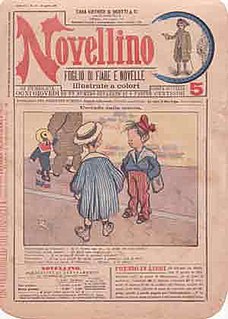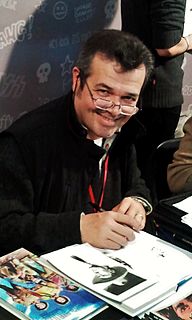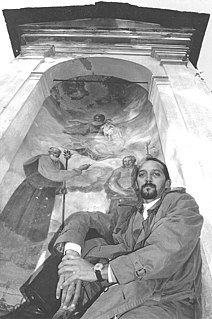Max Bunker, pen name of Luciano Massimiliano Secchi, is an Italian comic book writer, and publisher, best known as the co-author of Alan Ford.

Italian comics, also known as fumetto[fuˈmetto], plural form fumetti[fuˈmetti], are comics which originate in Italy. The most popular Italian comics have been translated into many languages. The term fumetto refers to the distinctive word balloons that contain the dialogue in comics.
Renzo Barbieri was an author and editor of Italian comics as well as the founder of the publishing house Edifumetto. In 1980 he wrote Il Manuale del Playboy, a textbook about where European playboys live, what cars they drive, and other lifestyle tips.

Kriminal is an Italian comics series featuring an eponymous fictional character, created in 1964 by Magnus and Max Bunker, the authors of Alan Ford, Maxmagnus and Satanik.

Satanik is an Italian noir comic book created in December 1964 by Max Bunker (writer) and Magnus (artist), also the authors of the popular series Kriminal and Alan Ford.
Dampyr is an Italian comic book series created by Mauro Boselli and Maurizio Colombo and first published by Sergio Bonelli Editore in 2000.

Claudio Villa is an Italian comics artist who has primarily worked with Sergio Bonelli Editore, and is currently involved in illustrating several books in the Tex Willer comic series. He has mostly drawn covers since number 400th, but sometimes also draws stories, such as Tex #501 - 504.

Carlo Ambrosini is an Italian comic book artist and writer.

Guido Crepas better known by his pen name Guido Crepax, was an Italian comics artist. He is most famous for his character Valentina, created in 1965 and very representative of the spirit of the 1960s. The Valentina series of books and strips became noted for Crepax's sophisticated drawing, and for the psychedelic, dreamlike storylines, generally involving a strong dose of erotism. His work was often politically motivated too, inspired by his Communist convictions. A film based on his work called Baba Yaga, featuring the character Valentina, was made in 1973.
Gesebel is an Italian science fiction comic book, created by writer Max Bunker and artist Magnus, who had previously created several other characters, such as Alan Ford, Kriminal, and Satanik.
Massimo Rotundo is an Italian comics artist.
Magnus, pseudonym of Roberto Raviola, was an Italian comic book artist, regarded as one of the foremost cartoonists of all time in his country.

Emanuele Tenderini is an Italian comic book artist.
Ernesto Rudesindo García Seijas is an Argentine comics artist.
Antonio Canale was an Italian comic writer and artist, also known under the pen name Tony Chan.
Raffaele Paparella was an Italian comic artist and illustrator.

Leone Cimpellin was an Italian comic artist. He was sometimes credited under the pen name Ghilbert.
Giovanni Romanini was an Italian comics artist and cartoonist.
Mario Uggeri was an Italian comic artist, illustrator and painter.








